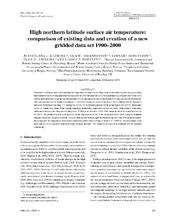High northern latitude surface air temperature: comparison of existing data and creation of a new gridded data set 1900–2000
Kuzmina, Svetlana I.; Johannessen, Ola M.; Bengtsson, Lennart; Aniskina, Olga G.; Bobylev, Leonid P.
Peer reviewed, Journal article
Permanent lenke
https://hdl.handle.net/1956/3219Utgivelsesdato
2008-03Metadata
Vis full innførselSamlinger
- Geophysical Institute [1187]
Originalversjon
https://doi.org/10.1111/j.1600-0870.2008.00303.xSammendrag
Detection, attribution and understanding of temperature changes in the high northern latitudes depend on constraining uncertainties and resolving apparent discrepancies in observational data sets. We quantitatively compare four of the most widely used data sets of surface air temperature (SAT), and present a newly produced SAT data set, called NansenSAT. The existing data sets are highly correlated (r ∼ 0.8–0.9), except for some ocean areas. The evolution of SAT anomalies indicates differences reaching 3 ◦ C during the 1920s–1930s warming period for the polar region (60–90◦ N). Substantial errors in trends also result from spatial sampling limitations, especially during the early–20th-century. Maximum differences between the data sets reaching 0.64 ◦ C/100 yr are found in 1900–1999 linear trends in July and October for 60–90◦ N. We produced a new SAT data set for the region north of 40◦ N for the period 1900–2000, using all available data and Objective Analysis methods. The new data set has been compared with existing SAT data. For the polar region, the magnitude of temperature-trend errors caused by sparse data coverage is about 0.5 ◦ C/100 yr. The advantage of the new data set is its enhanced spatial coverage in high latitudes. The NansenSAT data set is available for the research community.
Beskrivelse
Authors accepted postprint version.
